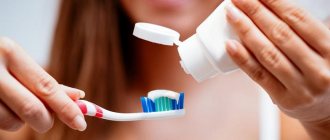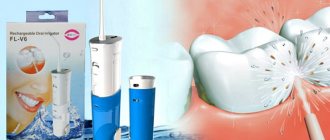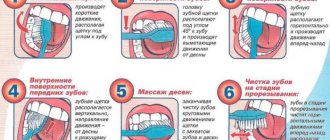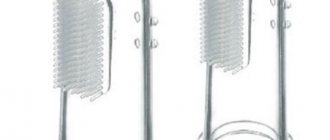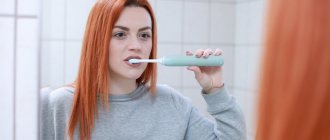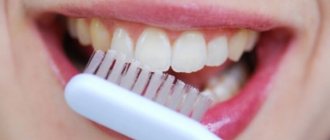From ash and sticks: what did our ancestors use to clean their teeth?
- Articles
- 6 June 2022, 09:16
The first week of summer, June 4, is International Tooth Caries Day. Read in the article “Kuban 24” how humanity cared for its teeth to advertising recommendations from the best dentists.
Miswak and ram's horn
Archaeologists suggest that primitive people began brushing their teeth 5000-3000 BC. e. — they chewed tree resin and beeswax. Later, salt, resin, plant particles, and charcoal were used as cleaning agents.
The first toothbrush and tooth powder recipes appeared in Ancient Egypt. The “brush” was a thin tree branch chewed at one end - a miswak (sivak).
Photo iney-cleaning.ru
The following drugs were used as tooth powder: a mixture of finely ground frankincense, myrrh, mastic tree, raisins and ram's horn; powder from ground ox entrails, myrrh, crushed pumice, eggshells.
Both recipes had the same drawback - an excess of abrasive elements in the composition, which severely damaged tooth enamel.
Also, the ancient Egyptians periodically rubbed their teeth with onions. In general, in Ancient Egypt it was prestigious to have healthy white teeth.
The first dentist - Hippocrates
The first doctor to formulate the medical necessity of brushing teeth was Hippocrates. He was the first to describe dental diseases. The Greeks were the first to treat teeth using lead fillings, and used wine and sea water as disinfectants.
The first toothpaste in Ancient Greece appeared in the 1500s BC. e. It included pumice, talc, crushed coral and iron oxides.
Ancient Rome did not “reinvent the wheel”, but adopted the methods of brushing teeth from the ancient Greeks. Later, Rome created its own tradition of dental treatment and care. A mixture of crushed oyster shells and honey with water was used as toothpaste.
Photo the300spartans.ru
Horns and hooves
In the East, Arabs, Indians and Chinese in ancient times had their own approaches to brushing teeth. For example, in China, powder from cattle hooves and horns and sea shells was used for this. In India, a mixture of salt, honey and ash was in use. Ash was taken from burnt wood, seaweed, rosemary or bread. After cleaning, rinse your mouth with rose water, mint or thyme infusion. By the way, these rinsing methods are still relevant today - they are useful.
The above-mentioned miswak was popular in Arabia and desert Muslim countries. This method did not require rinsing with water after cleaning, and in the desert countries of the Middle East, water was always worth its weight in gold. To prevent caries, Arabs chewed natural resins and incense.
Photo expertdent.net
Toothless Middle Ages
In the Middle Ages, having white and healthy teeth was considered bad form, which of course does not fit with the romance of knightly tournaments, beautiful princesses and crusades. But alas, historical sources do not lie - there was a misconception in medicine that you can become infected with deadly diseases through your teeth, and therefore it is better to remove them preventively. A common practice at that time was the special removal of all teeth. Marquises, counts and even kings boasted to each other about their toothless mouths.
Photo fishki.net
Throughout the Middle Ages, white and healthy teeth were a sign of commoners and peasants. By the way, people of the lower classes looked after and looked after their teeth - they used herbal and mineral mixtures and charcoal as toothpaste - ordinary people did not have money for powders made from expensive ingredients.
At the end of the 15th century, the prototype of a modern toothbrush appeared in China - a stick or bone with bristles from a pig or some other animal.
Photo biblio-on-line.blogspot.com
From China, the toothbrush in its modern form came to Europe. True, instead of pig bristles, they often began to use horse hair. Rich people had toothpicks made of gold, silver and precious stones.
How did our ancestors brush their teeth? It is reliably known that in Rus' the first toothbrushes - sticks with a tuft of bristles at the end (they were called “tooth brooms”) appeared during the time of Ivan the Terrible.
During his reign, Peter I was concerned about the appearance of his boyars and ordered them to brush their teeth with charcoal, chalk or a damp cloth.
From ash to fluorine
People used toothbrushes for several centuries until Louis Pasteur came up with the idea that they could harbor harmful bacteria. The popularity of toothbrushes subsided for a while. But then the brushes simply began to be changed more often.
In the 18th century, in England, tooth powder appeared in composition as close as possible to the modern one; it included soap shavings, crushed chalk and mint. But it was the privilege of the rich; the poor still brushed their teeth with charcoal or ash applied to their finger.
In the 19th century, mass production of toothbrushes began in England, France, and Germany. Russia and China became their suppliers of bristles. The wool of the Siberian boar was especially highly prized.
Photo chippfest.blogspot.com
In 1892, Washington Sheffield (a dentist by training) finds a revolutionary solution - a tube of toothpaste. He got the idea from artists who already had paints in tubes at that time. Since 1896, Colgate began producing toothpaste in tubes. And only in 1956 the first toothpaste containing fluoride appeared and was released.
At the same time, the evolution of the toothbrush continued. In 1938, synthetic fibers replaced natural bristles. In the same year, an electric toothbrush was invented in Switzerland, but it was not in demand. These brushes worked from the mains and were wired. Brushes with a built-in battery appeared much later.
Photo smiledesigns.com.au
According to numerous sociological surveys in many countries, the toothbrush and toothpaste are considered one of the main inventions of mankind.
Hand washing
People have been washing their hands since ancient times. Even the ancient Egyptians prepared detergents from a mixture of alkalis, fat and vegetable oils, the Assyrians used a mixture of alkali and castor oil, and in Ancient Rome there were many recipes for making soap. In medieval Europe, since at least the 900s (and most likely earlier), soap was produced on an industrial scale, and dinners, at least in aristocratic houses, always began with hand washing. Considering that back then people ate mostly from shared dishes and without cutlery, such a measure seems justified: it is not very pleasant to eat from a plate that has been touched by the dirty hands of your table neighbors.
Unfortunately, understanding the connection between dirty hands and disease was much worse.
Back in the 19th century, even a doctor could easily, after completing an autopsy of a corpse, go to deliver a baby without washing his hands.
The connection between hand washing and health was first discussed by the Hungarian doctor Ignaz Semmelweis in 1848. Dr. Semmelweis noticed that in two Viennese maternity wards the mortality rates of women in labor were very different, although the conditions were almost identical. The only difference was that one of the hospitals also had a morgue, and doctors worked there at the same time.
Semmelweis suspected: perhaps the fact is that doctors carry “particles of dead bodies” in their hands. He suggested that his colleagues, as an experiment, wash their hands and tools in a chlorine solution after each procedure. After this innovation, the mortality rate of women in the maternity ward of the hospital where Semmelweis worked fell from 18% to 1%. However, even the enormous success of the experiment could not convince the rest of the doctors: the very idea that they could be carriers of infections seemed offensive to them. The further fate of Semmelweis was tragic: he was fired from his job, he suffered a nervous breakdown and, understood by no one, ended his days in a psychiatric hospital.
But in subsequent years, science moved forward, doctors learned a lot more about germs and gradually began to take hand washing seriously. And by the beginning of the 20th century, people began to understand that hand washing is a good habit not only for surgeons, but for everyone else. This was largely facilitated by the first anti-tuberculosis campaigns: the population was actively explained that tuberculosis is not something that you inherit from your grandmother, but something that you can catch if your grandmother coughs on you. That’s why it’s so important to practice good hygiene, including washing your hands often.
For a time, people became literally obsessed with hygiene (some researchers argue that this was the reason why men at the turn of the century were less likely to grow beards: they were afraid of germs).
But with the spread of vaccines and antibiotics, the habit of washing hands began to be neglected again: to generations of “flower children” it seemed like a mossy bourgeois prejudice.
Only with the spread of HIV did people again remember the need to wash their hands - paradoxical, given that the virus is not transmitted through household contact.
Before the pandemic, however, things were not ideal. According to a 2009 study, only 69% of American women and 43% of men washed their hands after using the toilet, and even less before eating: 7 and 10%, respectively. However, if the study had been carried out this year, the figures would probably have been much higher: if the coronavirus pandemic has brought us anything useful, it is the habit of washing our hands at every opportunity.
Examination room: the head physician recalls
The first place a patient at a dental clinic went was the examination room. Diagnostics were carried out there. But, until relatively recently, dentists had few tools for it. They examined patients visually, palpated their mouths to look for loose teeth or swelling, tapped with metal tweezers to determine inflammation, or picked at a tooth with a probe. Diagnosis was based on the patient's pain response.
Emergency care was also provided in the examination room. For example, in case of pulpitis - inflammation of the pulp (nerve) of a tooth, in which a person experiences acute pain, the inflamed nerve was “killed” with arsenic. It was placed in the tooth for several days. After this, the inflammation site was sealed with a mummifying compound - resorcinol-formalin.
Both drugs are dangerous and can cause additional complications. For example, arsenic could cause osteonecrosis - tissue death. And because of the resorcinol-formalin method, the teeth became fragile and “fused” with the surrounding tissues. It was almost impossible to pull out such a tooth without destruction.
Tooth extraction forceps
Photo: museum.historymed.ru
“I remember children’s screams and the squeal of the drill”: Oleg, 44 years old.
My first memories of going to the dentist are the narrow corridor of the clinic in Severo-Zapadny, children crying and a smell that cannot be confused with anything. One winter in the mid-80s, I, a junior high school student, suddenly began to have problems with my teeth - first caries, then stomatitis, so much so that I could hardly eat due to inflammation of the mucous membrane. So I was introduced to the world of toothache and all the other accompanying horrors.
In fact, I remember a little - apparently, my memory helpfully swept all the worst things into its farthest corners. But this smell and the children's cries - oh, yes. Moreover, the long wait in the corridor was much worse than the treatment itself - you listened with bated breath to the sounds of instruments clinking, the drill terribly screeching, the patients humming, groaning or simply screaming. And he waited, waited, waited for his turn to fall helplessly onto a hard chair and endure the terrible manipulations through tears. A couple of years later I had eye surgery under local anesthesia - and it wasn’t scary at all, because these are eyes, not TEETH. Big deal.
Removal: the head physician recalls
Anesthesia in those years was ineffective. It was made with Novocaine or Lidocaine. These drugs began to act only after 15 minutes, so the doctors gave an injection and sent the patient into the corridor. Moreover, anesthesia was administered with syringes with reusable needles, which were boiled for disinfection. Over time, the needles became dull, so they were made thicker to make them easier to sharpen.
The patient's appointment took 20-30 minutes, so the doctor had to remove the tooth very quickly. There was no talk of any caution, so sometimes the tooth was removed along with a fragment of the bone tissue in which it was fixed. Today, when removing a tooth, it is important to preserve the bone in order to be able to install an implant.
“Grandfather constantly lost his galoshes”: Alla, 48 years old
My grandfather's dentures were a constant joke in our family. And the joke was not on him, but on himself.
Now I understand that “galoshes,” as he called them, caused him a lot of inconvenience. Because of them, he had problems with speech, it was not very convenient for him to eat, especially since they were constantly trying to fall out of his mouth at the most inopportune moment.
My grandmother said that my grandfather waited a very long time for his turn to get prosthetics, even though he was a war veteran. But in those days there were many veterans, and only a few clinics dealt with prosthetics.
Dentures don't look very comfortable
Photo: museum.historymed.ru




